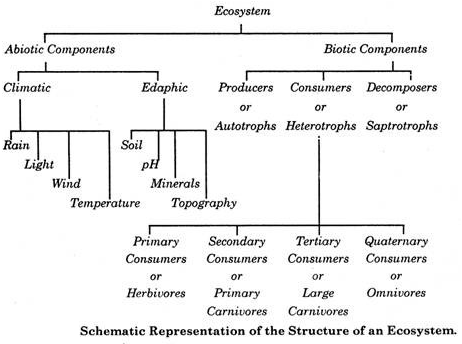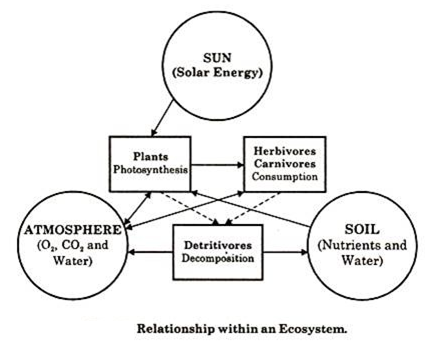structure and function of an ecosystem
Each ecosystem has two main components:
(1) Abiotic
(2) Biotic
(1) Abiotic Components:
The non living factors or the physical environment prevailing in an ecosystem form the abiotic components. They have a strong influence on the structure, distribution, behaviour and inter-relationship of organisms.
Abiotic components are mainly of two types:
(a) Climatic Factors:
Which include rain, temperature, light, wind, humidity etc.
(b) Edaphic Factors:
Which include soil, pH, topography minerals etc.?
The functions of important factors in abiotic components are given below:
Soils are much more complex than simple sediments. They contain a mixture of weathered rock fragments, highly altered soil mineral particles, organic matter, and living organisms. Soils provide nutrients, water, a home, and a structural growing medium for organisms. The vegetation found growing on top of a soil is closely linked to this component of an ecosystem through nutrient cycling.
The atmosphere provides organisms found within ecosystems with carbon dioxide for photosynthesis and oxygen for respiration. The processes of evaporation, transpiration and precipitation cycle water between the atmosphere and the Earth’s surface.
Solar radiation is used in ecosystems to heat the atmosphere and to evaporate and transpire water into the atmosphere. Sunlight is also necessary for photosynthesis. Photosynthesis provides the energy for plant growth and metabolism, and the organic food for other forms of life.
Most living tissue is composed of a very high percentage of water, up to and even exceeding 90%. The protoplasm of a very few cells can survive if their water content drops below 10%, and most are killed if it is less than 30-50%.
Water is the medium by which mineral nutrients enter and are trans-located in plants. It is also necessary for the maintenance of leaf turgidity and is required for photosynthetic chemical reactions. Plants and animals receive their water from the Earth’s surface and soil. The original source of this water is precipitation from the atmosphere.
(2) Biotic Components:
The living organisms including plants, animals and micro-organisms (Bacteria and Fungi) that are present in an ecosystem form the biotic components.
On the basis of their role in the ecosystem the biotic components can be classified into three main groups:
(A) Producers
(B) Consumers
(C) Decomposers or Reducers.
(A) Producers:
The green plants have chlorophyll with the help of which they trap solar energy and change it into chemical energy of carbohydrates using simple inorganic compounds namely water and carbon dioxide. This process is known as photosynthesis. As the green plants manufacture their own food they are known as Autotrophs (i.e. auto = self, trophos = feeder)
The chemical energy stored by the producers is utilised partly by the producers for their own growth and survival and the remaining is stored in the plant parts for their future use.
(B) Consumers:
The animals lack chlorophyll and are unable to synthesise their own food. Therefore, they depend on the producers for their food. They are known as heterotrophs (i.e. heteros = other, trophos = feeder)
The consumers are of four types, namely:
(a) Primary Consumers or First Order Consumers or Herbivores:
These are the animals which feed on plants or the producers. They are called herbivores. Examples are rabbit, deer, goat, cattle etc.
(b) Secondary Consumers or Second Order Consumers or Primary Carnivores:
The animals which feed on the herbivores are called the primary carnivores. Examples are cats, foxes, snakes etc.
(c) Tertiary Consumers or Third Order Consumers:
These are the large carnivores which feed on the secondary consumers. Example are Wolves.
(d) Quaternary Consumers or Fourth Order Consumers or Omnivores:
These are the largest carnivores which feed on the tertiary consumers and are not eaten up by any other animal. Examples are lions and tigers.
(C) Decomposers or Reducers:
Bacteria and fungi belong to this category. They breakdown the dead organic materials of producers (plants) and consumers (animals) for their food and release to the environment the simple inorganic and organic substances produced as by-products of their metabolisms.
These simple substances are reused by the producers resulting in a cyclic exchange of materials between the biotic community and the abiotic environment of the ecosystem. The decomposers are known as Saprotrophs (i.e., sapros = rotten, trophos = feeder)



